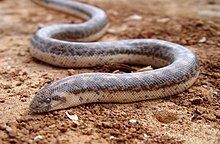
The Boidae, commonly known as boas or boids, are a family of nonvenomous snakes primarily found in the Americas, as well as Africa, Europe, Asia, and some Pacific islands. Boas include some of the world's largest snakes, with the green anaconda of South America being the heaviest and second-longest snake known; in general, adults are medium to large in size, with females usually larger than the males. Six subfamilies comprising 15 genera and 54 species are currently recognized.

Aspidites is a genus of pythons endemic to Australia. The name can be translated as "shield bearer" and pertains to the symmetrically shaped head scales. Currently, two species are recognized.
The Uropeltidae, also commonly known as shield-tail snakes, shield-tailed snakes or earth snakes, are a family of primitive, nonvenomous, burrowing snakes native to Peninsular India and Sri Lanka. The name is derived from the Greek words ura ('tail') and pelte ('shield'), indicating the presence of the large keratinous shield at the tip of the tail. Seven or eight genera are recognized, depending on whether Teretrurus rhodogaster is treated in its own genus or as part of Brachyophidium. The family comprises over 50 species. These snakes are not well known in terms of their diversity, biology, and natural history.

The Calabar python is a species of non-venomous snake in the family Boidae. The species is endemic to West and Central Africa. It is the only species in its genus.
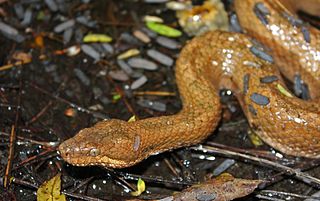
The Tropidophiidae, common name dwarf boas or thunder snakes, are a family of nonvenomous snakes found from Mexico and the West Indies south to southeastern Brazil. These are small to medium-sized fossorial snakes, some with beautiful and striking color patterns. Currently, two living genera, containing 34 species, are recognized. Two other genera were once considered to be tropidophiids but are now known to be more closely related to the boids, and are classified in the subfamily Ungaliophiinae. There are a relatively large number of fossil snakes that have been described as tropidophiids, but which of these are more closely related to Tropidophis and Trachyboa and which are more closely related to Ungaliophis and Exiliboa is unknown.

Eryx johnii is a species of nonvenomous snake in the subfamily Erycinae of the family Boidae. The species is native to Iran, Pakistan, and India. There are no subspecies which are recognized as being valid.

Eryx whitakeri, also commonly known as Whitaker's sand boa or Whitaker's boa, is a species of nonvenomous snake in the subfamily Erycinae of the family Boidae. The species is endemic to India. No subspecies are recognized.

Eryx conicus, also known as Russell's sand boa, the Common sand boa or the rough-tailed sand boa, is a species of non-venomous snake in the subfamily Erycinae of the family Boidae. The species is native to Southern Asia. No subspecies are recognised.

Candoia is a genus of non-venomous boas found mostly in New Guinea, Melanesia, the Solomon Islands and the Maluku Islands in Indonesia. Common names include bevel-nosed boas and keel-scaled boas.
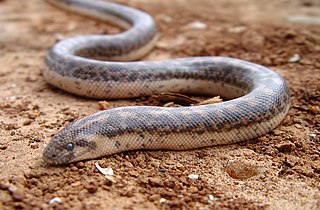
Eryx is a genus of nonvenomous snakes, commonly known as Old World sand boas, in the subfamily Erycinae of the family Boidae. Species of the genus are found in southeastern Europe, northern Africa, the Middle East, and southwestern Asia. Thirteen species are recognized as being valid.
Eryx elegans is a boa species endemic to western Central Asia. Like all other boas, it is not venomous. No subspecies are recognized.

The Round Island burrowing boa is an extinct species of snake, in the monotypic genus Bolyeria, in the family Bolyeriidae. The species, which was endemic to Mauritius, was last seen on Round Island in 1975. There are no recognized subspecies.

Trachyboa is a genus of nonvenomous dwarf boas endemic to Central and South America. They are largely terrestrial, fish-eating snakes that inhabit tropical lowlands. Two species are recognized.

Eryx colubrinus, the Egyptian or Kenyan sand boa, is a species of snake in the family Boidae. The species is endemic to Northern and Eastern Africa. Three subspecies are recognized.
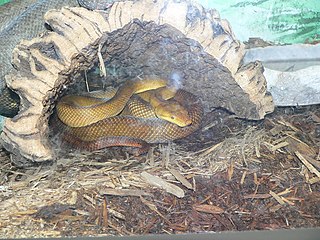
Candoia bibroni—commonly known as Bibron's bevel-nosed boa, Bibron's keel-scaled boa, the Pacific tree boa or the Fiji boa—is a species of boa, a group of non-venomous, constricting snakes, endemic to the southern Pacific Ocean island chains of Melanesia and Polynesia. Two subspecies are recognized, including the nominate subspecies, described here. Candoia bibroni is one of the most isolated and far-removed species of boid snakes on earth, as the majority of boa species are found in the Americas and the Caribbean, or, in the case of the terrestrial sand boas, in Africa and Eurasia.

Eryx jaculus, known commonly as the javelin sand boa, is a species of snake in the Boidae family. It is the type species of the genus Eryx.
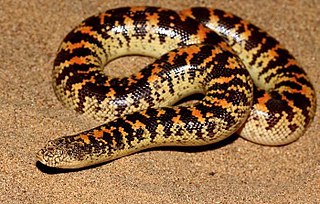
Eryx jayakari, known commonly as the Arabian sand boa or Jayakar's sand boa, is a species of snake in the family Boidae. The species is endemic to the Arabian Peninsula and Iran where it spends the day buried in the sand.
